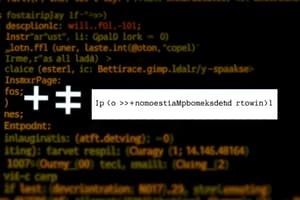Podcast
Questions and Answers
What is a reference variable in C++?
What is a reference variable in C++?
- A reference variable is an alias for an existing variable, created with the % operator
- A reference variable is a "reference" to an existing variable, created with the & operator (correct)
- A reference variable is a pointer to an existing variable, created with the * operator
- A reference variable is a copy of an existing variable, created with the = operator
How is a named structure created in C++?
How is a named structure created in C++?
- By declaring a variable with the name of the structure as the data type
- By using the define keyword followed by the name of the structure
- By putting the name of the structure right after the struct keyword (correct)
- By using the typedef keyword followed by the name of the structure
What does the & operator do in C++?
What does the & operator do in C++?
- Perform bitwise AND operation and get the result as an address
- Indicate logical AND operation and retrieve the address of a variable
- Create a pointer variable and get the value stored in a memory address
- Create a reference variable and get the memory address of a variable (correct)
What does it mean when a variable's memory address is mentioned?
What does it mean when a variable's memory address is mentioned?
How are references and pointers related in C++?
How are references and pointers related in C++?
What is the purpose of the & operator in C++ and how is it used to create a reference variable?
What is the purpose of the & operator in C++ and how is it used to create a reference variable?
How is the memory address of a variable obtained in C++ and why is it useful to know the memory address?
How is the memory address of a variable obtained in C++ and why is it useful to know the memory address?
What happens when a value is assigned to a variable in C++ and how is it related to the memory address?
What happens when a value is assigned to a variable in C++ and how is it related to the memory address?
In C++, how is a named structure created and how is it used to declare a variable?
In C++, how is a named structure created and how is it used to declare a variable?
What is the relationship between references and pointers in C++?
What is the relationship between references and pointers in C++?
Flashcards are hidden until you start studying
Study Notes
C++ Structures
- A structure is a way to group several related variables into one place, each known as a member of the structure.
- Unlike an array, a structure can contain many different data types (int, string, bool, etc.).
- To create a structure, use the
structkeyword and declare each of its members inside curly braces.
Declaring a Structure
- After the declaration, specify the name of the structure variable.
- Example:
struct MyStructure { ... };
Accessing Structure Members
- Use the dot syntax (.) to access members of a structure.
- Example:
myStructure.memberVariable
Using One Structure in Multiple Variables
- Use a comma (,) to declare multiple variables with the same structure.
- Example:
struct MyStructure { ... }; MyStructure var1, var2, var3;
Named Structures
- By giving a name to the structure, you can treat it as a data type.
- This allows you to create variables with this structure anywhere in the program at any time.
Studying That Suits You
Use AI to generate personalized quizzes and flashcards to suit your learning preferences.




